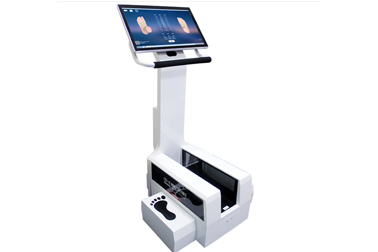With the development of modern medical and biomechanics technologies, foot scanners have been widely used in areas such as foot health management, orthotic design, and sports medicine. Many people may be concerned about whether foot scanners emit radiation and whether they can impact health. This article will comprehensively analyze this issue from the perspective of the working principle of foot scanners, technology types, potential radiation sources, and their safety, answering the question in a scientifically rigorous manner.
A foot scanner is a device used to acquire data about the shape and structure of the foot. Whether or not it emits radiation depends on the technology used. The main foot scanning technologies available on the market today include optical scanning, X-ray scanning, ultrasound scanning, and pressure sensor scanning. Optical scanning technologies mainly use non-contact optical measurement methods, such as lasers or structured light, to create three-dimensional shape data through the reflection of light. These devices use visible or near-infrared light, which is non-ionizing radiation and harmless to the human body. X-ray scanning uses X-rays to penetrate the soft tissue of the foot and generate skeletal images, mainly used for medical diagnosis. However, X-rays are ionizing radiation, and their use requires strict control of frequency and radiation dosage. Ultrasound scanning uses ultrasonic signals to generate soft tissue structural information of the foot, and it does not involve ionizing radiation. Pressure sensor scanning records the force distribution when the foot makes contact with the ground, without any radiation source.

Application of Foot Scanners In practical applications, whether or not foot scanners emit radiation depends on the technology they use. Lasers used in optical scanners are low-power light sources and generally do not pose a risk to skin or eyes (unless there is prolonged direct exposure to strong light). Structured light sources are mostly LED lights, which are non-ionizing radiation and harmless to the human body. X-ray scanners, which use ionizing radiation, do carry some risk. However, modern medical equipment strictly controls radiation doses, and the amount of radiation in a single scan is typically well below the human threshold, only being used when necessary. Ultrasound and pressure sensor technologies do not involve radiation and are considered highly safe.
The safety of foot scanners is generally ensured in everyday use. Most devices (such as optical, ultrasound, and pressure sensor scanners) do not have radiation risks and are suitable for the general population. The laser power used in laser scanners is low and strictly complies with international laser safety standards, causing little to no health impact. For X-ray scanners, because they involve ionizing radiation, it is recommended to use them moderately under a doctor’s advice, especially for pregnant women and children, where extra caution is needed.
To ensure the safe use of foot scanners, several measures should be taken. First, choose devices that meet international or national safety standards, such as optical scanners that comply with IEC 60825 laser safety standards. Second, operate the equipment according to the guidelines, such as avoiding prolonged direct exposure to the laser source and wearing protective equipment when using X-ray scanners. Lastly, regularly maintain and calibrate the devices to ensure that light sources and sensors are in good condition and avoid potential safety hazards.
The safety of foot scanners is closely related to the type of technology they use. Optical, ultrasound, and pressure sensor devices can be considered completely safe, with no radiation concerns. A few devices that use X-ray technology do involve ionizing radiation, but when radiation doses are controlled, the health impact is minimal. As long as compliant products are chosen and operated according to guidelines, foot scanners, as an efficient and reliable tool, can be widely and safely applied in the medical and health fields.
